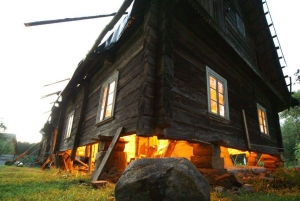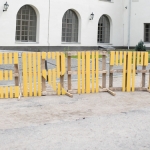Inherited values in wooden homesteads: protecting, looking after and conserving. How and why?
 When talking about heritage, most of us think about grand natural and human created monuments such as churches, medieval castles and strongholds, museological and antiquarian valuables and other objects that usually are not part of our everyday lives. Only very rarely we think about our grandparents’ homes, where we spend (or used to spend) our summers, as heritage and that we have a possibility to take part in caring after and cherishing them. The old wooden houses, their architecture and surroundings are a unique and valuable legacy, the base of our identity, our traditions and marks of our historical memory.
When talking about heritage, most of us think about grand natural and human created monuments such as churches, medieval castles and strongholds, museological and antiquarian valuables and other objects that usually are not part of our everyday lives. Only very rarely we think about our grandparents’ homes, where we spend (or used to spend) our summers, as heritage and that we have a possibility to take part in caring after and cherishing them. The old wooden houses, their architecture and surroundings are a unique and valuable legacy, the base of our identity, our traditions and marks of our historical memory.
The renewal of an old wooden house usually seems difficult, a time and money consuming process. But with proper evaluation of the condition of the house, also with careful planning, this may become a pleasurable pastime that lets you spend time in nature and deepen the bond between generations that built these homes and the ones that are taking care of them now. So what are the most important steps and how to correctly realize them in order to preserve the uniqueness of the architecture but also create comfortable living conditions?
First step – realize the values of the house and learn to “communicate” with it
The main building of the homestead was usually wooden. Wood is a material that is always changing, it reacts to changes in the environment, it moves, it spreads, it shrinks, it’s a live organism. Dr. Rasa Bertašiūtė says that before any work can be done, it’s very important to realize the value of the building – its architectural, historical and other values, that need to be  preserved. It is also necessary to evaluate the nature, scope and reasons of various “injuries” and carefully plan your next steps: what needs to be done right away to avoid threatening changes (for example – leaky roof, stuffed or broken rain gutters, etc.) and what can be done next to fix the main problems of the house, to renew decayed elements (for example – painting the walls, fixing the windows, etc.). The less we change an old building, the more information we leave to future generations.
preserved. It is also necessary to evaluate the nature, scope and reasons of various “injuries” and carefully plan your next steps: what needs to be done right away to avoid threatening changes (for example – leaky roof, stuffed or broken rain gutters, etc.) and what can be done next to fix the main problems of the house, to renew decayed elements (for example – painting the walls, fixing the windows, etc.). The less we change an old building, the more information we leave to future generations.
Strong foundation and a good roof – the guarantee to longevity
The most important things to a healthy life of a house – the foundation and the roof. The greatest damage is brought by moisture – ground water, rain, snow, bad ventilation. Moisture-affected wood is easily violated, it can become rotten, mouldy. And moisture usually comes through a bad foundation and an incorrectly fixed roof. Before starting any conservation works it is important to check if there is a proper water slope, if there are any cracks in the foundation, any flaked off plaster or any sinking in the foundation. After taking care of the houses’ “feet” and making sure they are secure and dry, the next step is to evaluate and fix the roof, protect the house from rain and snow damage.  Again, it is important to check for any visible violations, whether there are any moisture-affected roof constructions, rafters for example, whether the ridge of the roof is leak-proof, whether the rain gutters are correctly installed and clean and whether the water from the rain gutters doesn’t splatter on the walls or the foundation. A simple step like cleaning the rain gutter is very important. If the old roof needs to be changed, one of the main things that need to be considered, according to dr. Rasa Bertašiūtė, is the preservation or repeating of the original shape, construction, proportion and material of the roof. Technical aspects are also very important not only for the longevity of the house, but also for safety – calculations need to be made when making sure the new roof is not going to be too heavy for the house, especially when considering a new roofing material.
Again, it is important to check for any visible violations, whether there are any moisture-affected roof constructions, rafters for example, whether the ridge of the roof is leak-proof, whether the rain gutters are correctly installed and clean and whether the water from the rain gutters doesn’t splatter on the walls or the foundation. A simple step like cleaning the rain gutter is very important. If the old roof needs to be changed, one of the main things that need to be considered, according to dr. Rasa Bertašiūtė, is the preservation or repeating of the original shape, construction, proportion and material of the roof. Technical aspects are also very important not only for the longevity of the house, but also for safety – calculations need to be made when making sure the new roof is not going to be too heavy for the house, especially when considering a new roofing material.
Taking care of the walls
 Usually the most affected parts of the walls are the lower logs, which can be changed when fixing the foundation. Though other parts of the walls have to be also considered, as they are affected by rain, snow and sunlight as much as any other part of the house (usually in the southern part of the house and where the logs are connected). It is important to evaluate the degree of the violations – if they’re minor, it may be enough to change a part of the log, if they’re more serious or potentially dangerous, the walls may need to be remade. Even though the authentic look of the old walls may be most appealing to people, there are many possibilities to fix up the house in order to create more comfortable living conditions.
Usually the most affected parts of the walls are the lower logs, which can be changed when fixing the foundation. Though other parts of the walls have to be also considered, as they are affected by rain, snow and sunlight as much as any other part of the house (usually in the southern part of the house and where the logs are connected). It is important to evaluate the degree of the violations – if they’re minor, it may be enough to change a part of the log, if they’re more serious or potentially dangerous, the walls may need to be remade. Even though the authentic look of the old walls may be most appealing to people, there are many possibilities to fix up the house in order to create more comfortable living conditions.
If fixing the foundation and the roof, or changing logs may be too difficult without the help of a professional, smaller conservation works such as fixing doors, windows, fences, wells, sheds or other smaller architectural elements may definitely be done with your own hands!
By Milda Petrokaitė.
Photos: UAB “Jautmalkės lėpis”

